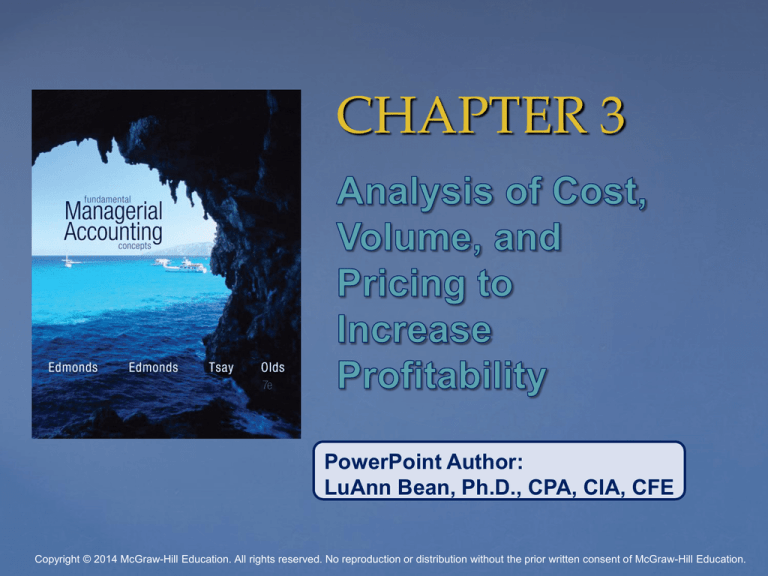
CHAPTER 3
PowerPoint Author:
LuAnn Bean, Ph.D., CPA, CIA, CFE
Copyright © 2014 McGraw-Hill Education. All rights reserved. No reproduction or distribution without the prior written consent of McGraw-Hill Education.
The Equation Method
At the break-even point:
Sales = Variable cost + Fixed cost
We can look at the above equation like this:
Selling price per unit
×
Number of units sold
=
Variable cost per unit
×
Number of units sold
+
Fixed cost
3-2
Determining the Break-Even
Point Using the Equation Method
The break-even point is the point where total revenue
equals total costs (both variable and fixed). For Bright
Day, the cost of advertising is estimated to be $60,000.
Advertising costs are the fixed costs of the company. We
use the following formula to determine the break-even
point in units.
The equation method begins by expressing the income statement
as follows. At the break-even point, profit is equal to zero.
Sales – Total variable cost – Total fixed cost = Profit
$36N - $24N - $60,000 = 0
$12N = $60,000
N = $60,000/$12 = 5,000 Units
3-3
Determining the Contribution
Margin per Unit
The contribution margin per bottle of Delatine is:
Sales revenue per bottle
Variable cost per bottle
Contribution margin per bottle
Break-even
volume in units
=
=
$ 36
24
$ 12
Fixed costs
Contribution margin per unit
$60,000
= 5,000 units
$12
3-4
Determining the Break-even
Point
The break-even sales volume expressed in dollars
can also be determined by dividing the fixed cost by
the contribution margin ratio (which is contribution
margin divided by sales) computed using either total
or per unit figures.
Contribution margin ratio = Contribution margin ÷ Sales
Break-even
=
volume in dollars
=
Fixed costs
Contribution margin ratio
$60,000
= $60,000 = $180,000
$60,000 / $180,000
.33333
3-5
Reaching a Target Profit
Bright Day’s president wants the advertising campaign
to produce profits of $40,000 to the company.
Sales – Total variable cost – Total fixed cost = Profit
$36N - $24N - $60,000 = $40,000
N = $100,000/$12 = 8,333.33 Units
Sales
Fixed costs + Desired profit
=
volume in units
Contribution margin per unit
=
$60,000 + $40,000
$12
= 8,334 units
3-6
Effects of Changes in Sales Price
Using the equation method, the units required to
yield a $40,000 profit are:
Sales – Total variable cost – Total fixed cost = Profit
$28N - $24N - $60,000 = $40,000
$4N = $100,000
N = $100,000/$4 = 25,000 Units
Using the contribution margin per unit method:
= $60,000 + $40,000
$4
=
25,000 units
3-7
Effects of Changes in Sales Price
The required sales volume in dollars is $700,000 (25,000
units × $28 per bottle) as shown below:
Units sold
Revenue @ $28
Variable Expenses @ $24
Contribution Margin @$4
Fixed Expenses
Net Income
Income
25,000
$ 700,000
(600,000)
100,000
(60,000)
$ 40,000
3-8
Assessing the Effects of
Changes in Variable Costs
Sales – Total variable cost – Total fixed cost = Profit
$28N - $12N - $60,000 = $40,000
$16N = $100,000
N = $100,000/$16 = 6,250 Units
Break-even
Fixed costs + Desired profit
=
volume in units
Contribution margin per unit
=
$60,000 + $40,000
= 6,250 units
$16
3-9
Assessing the Effects of
Changes in Fixed Costs
Bright Day’s president has asked you to determine the
required sales volume if advertising costs were reduced
to $30,000, from the planned level of $60,000.
Sales – Total variable cost – Total fixed cost = Profit
$28N - $12N - $30,000 = $40,000
$16N = $70,000
N = $70,000/$16 = 4,375 Units
Break-even
volume (units)
=
$30,000 + $40,000
=
$16
3-10
Cost-Volume-Profit Graph
3-11
Calculating the Margin of Safety
The margin of safety measures the cushion between budgeted sales
and the break-even point. It quantifies the amount by which actual
sales can fall short of expectations before the company will begin to
incur losses.
Break-even
volume (units) =
$30,000 ÷ $16 = 1,875 units
Budgeted sales
Break-even sales
Margin of safety
In Units
4,375
(1,875)
2,500
In Dollars
$ 122,500
(52,500)
$ 70,000
Margin of = Budgeted sales – Break-even sales
Budgeted sales
safety
Margin of
$122,500 – $52,500
safety =
$122,500
= 57.14%
3-12
Break-Even Analysis for
Multiple Products
Synthetic C
Sales Price
Variable Cost
Contribution Margin
Organic C
$7
$9
5
6
$2
$3
The first step in determining the break-even point is to
compute the
weighted average contribution margin per unit.
3-13
Break-Even Analysis for
Multiple Products
Using the per unit contribution margin approach,
the break-even point in total units can be determined by
dividing the fixed cost by the weighted average contribution
margin as follows.
Break-even
Fixed costs
=
sales
Weighted average per unit cont. margin
Break-even
= $2,112/$2.20 = 960 total units
sales
3-14
Cost-Volume-Profit Limitations
CVP is limited by a number of underlying assumptions.
1
2
3
• The selling price is constant.
• Costs are linear.
• The multiproduct sales mix is constant.
4
• Inventory levels in manufacturing companies are
constant.
5
• All CVP variables are within the relevant range.
3-15
End of Chapter 3
3-16








